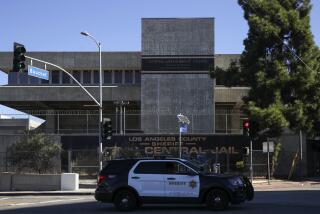Orange County Voices : COMMENTARY ON CORRECTIONAL REFORM : Privatizing Prisons, Jails More Problematic Than Promising : While it’s seen as a panacea, the projected cost savings could be short-lived and at the expense of standards.
For years, policy-makers, practitioners, scholars and others have been actively searching for ways to improve America’s ailing correctional system. By most measures, we have been spending more and doing worse. Amid more recent proposals and alternatives has been that of privatization--giving the private sector a significant role in the administration, financing and construction of correctional facilities. This is beginning to occur in Orange County with small jail-holding facilities in Seal Beach and Irvine.
“Selling the walls” may seem to make sense given both our dismal record in corrections and the severity of government budget shortfalls. A closer look, however, reveals myriad potential problems.
The interest in privatization has intensified as a response to increasing jail and prison populations, burgeoning costs and the widespread perception that the government-administered criminal justice bureaucracy has failed in its mission of appropriately dealing with convicted criminals. As these conditions worsen, interest in private corrections initiatives will increase. While there has always been a place for the private sector in contracting goods and services with public agencies, turning over jail and prison systems to profit-making enterprises could be a huge mistake, not only in terms of constitutional issues but in terms of taxpayer costs as well.
Opponents of privatization contend that private correctional systems put cost reductions above responsibility of a government for its prisoners. Government is in charge of domestic defense, which includes correctional systems.
Proponents, on the other hand, argue that such philosophical objections are a luxury that an overcrowded system cannot afford. They also contend that private correctional systems are less costly to operate than existing facilities because they are designed with economy in mind.
Despite the claims of both sides, there is little reliable information or enough research to tell us how privatization can work, whether it can solve our current problems and at what human and financial cost. Even if such answers were available, however, the more basic and perhaps most important question of contracting out people’s freedom to the lowest bidder would remain untouched.
The major perceived benefit of privatization is cost reduction and taxpayer savings. While some studies exist that show the average cost per inmate to be lower in private versus public institutions, critics contend that these savings will be short-lived and that long-term expenses will exceed current correctional costs.
For example, cost-cutting measures could run rampant, as not only taxpayers’ voices in decisions are lost but also the government’s control over quality of construction of facilities. Minimum standards for government would become maximum standards for the private sector, allowing it to save money in order to ensure profits. The shortcomings of low-quality construction surface later in the form of increased maintenance and renovation costs.
Most importantly perhaps, the government and taxpayers bear the responsibility and cost of monitoring compliance. No matter how much we would like to do so, government and taxpayer liability in this realm cannot be eliminated by delegating powers to a private entity. Thus, without rigorous government oversight (and related taxpayer costs), privatization efforts could backfire. When these costs are considered, the economic advantages of privatization begin to fade.
Another point that is often overlooked in assessing privatization is that private industry is already deeply involved in corrections policy. Recent research has identified a “corrections-commercial complex” akin to the military-industrial complex that operates without public scrutiny and exercises enormous influence over corrections policy.
As participants in this complex define their activities in the public interest, it becomes increasingly difficult to ascertain how much benefit accrues to taxpayers and government and how much to profit-oriented companies whose interest lies in building and operating as many facilities as cheaply as possible. Soaring correctional budgets, waste and inefficiency, defective construction and inadequate services could follow.
Even more disturbing, however, is the distinct possibility of a connection between “get-tough-on-crime” politics and the profit-generating interests of the corrections industry.
As late as the 1960s, jails and prisons in many parts of the United States (including California) were privately owned and operated. Their record was nothing short of scandalous. Gross exploitation of prison labor, fraud, political corruption and sheer brutality have characterized private corrections in America.
There is no question that something must be done to improve the state of our nation’s prisons and jails. Orange County has wallowed in its own jail overcrowding problems for well over a decade. Crime and punishment in a free society involve complex questions that are betrayed by simple solutions.
Private jails and prisons do not offer a correctional free lunch. Whatever direction is taken regarding privatization, a thoughtful and complete review must be given to all of the issues involved. How we resolve them will say a great deal about how we wish to be perceived as a society. Until this occurs, rushing into privatization is inappropriate.
More to Read
Sign up for Essential California
The most important California stories and recommendations in your inbox every morning.
You may occasionally receive promotional content from the Los Angeles Times.










